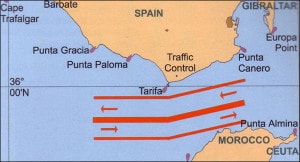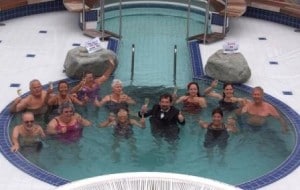We are on one of those stretches again that are too long for a one night crossing and too short for a full two days. Thus we got one sea day in the schedule and sailed with an average speed of 13 knots from Casablanca to Cartagena, where we will be tomorrow. It gave the opportunity for some sightseeing as we passed through the Straits of Gibraltar during daylight. When we left from Casablanca I went a bit further off the coast than the optimum course line required but if the optimum course line runs over multiple shoals of fishermen, then that course line is not so optimum any more. By staying about 30 miles offshore and away from the 200 meter line of water depth we avoided all those fishermen. Some other ships that did for the shortest route had to contend with long fishing nets and their owners and that can give rise to some stressful situations. So we heard the exclamations of the fishermen quite loudly over the VHF: “captain, captain, think about my children…..” etc. etc. So I thought about “his children” and stayed away as far as possible. As a result the officers only had to deal with a few strays that were chasing fish off the beaten path but they were easily dealt with.

By 07.45 we were lined up on the Eastern approach to the Vessel Traffic Separation Scheme that splits the Strait into a westbound traffic flow and an eastbound traffic flow. Ships that have to cross this highway at sea should do so on a 90o angle or as close to that angle as possible. This according to the Rules of the Road, although the latter part of the rules…or as close as possible……… leaves a bit of a loophole and as a result you come across very strange variations of a 90o angle. Especially ships manned with Far Eastern Nationals who seem to have a very peculiar interpretation of what 90o is. Still on the whole it works quite well. There is a traffic control system which checks what sort of ship you are and what cargo you are carrying In case of a collision or a fire. Then they will then know what they are dealing with, especially as a lot of dangerous cargo comes through. For Eastbound traffic that is done by Tangiers Traffic on the African side and for Westbound traffic it is Tariffa Traffic on the Spanish side.
A second rule that we are asked to comply with, although it is voluntary, is not to go any faster than 13 knots between April and October as then there seems to be a heightened concentration of Whales in the area. We did not see any whales during our transit but we did see 100’s of small Dolphins. This speed reduction is voluntary and as Holland America tries to respect nature wherever possible we did comply of course. It was a bit disappointing to see that some container ships, gas tankers and even a cruise ship did not comply at all. Same for the local ferries, they maintain their speed schedule as normal.
Due to the fact that this High pressure system was lying over the area, there was hardly any wind and that meant that the sand in the air was not blown away but the dust just seemed to hang there. That reduced visibility down to 7 miles and as a result we only saw the Rock, located on the other side of the Strait, when we were nearly abeam of it. We could not get any closer as we had to follow the inbound or east going lane and therefore had to stay on the African Side. It was very busy, as it always is; and in an area of 10 miles around us I counted 75 ships going either West or East, not counting those at anchor.
 While all this was going on, our guests were of course occupied with doing really important things, such as swimming through the Straits of Gibraltar. As I was not planning to stop for them while they dipped into the real waters, our cruise director Thom Faulkner had recreated the “Pillars of Hercules” in the ships Lido pool. To simulate the real swim. I suppose after a few glasses of champagne they might have even believed it.
While all this was going on, our guests were of course occupied with doing really important things, such as swimming through the Straits of Gibraltar. As I was not planning to stop for them while they dipped into the real waters, our cruise director Thom Faulkner had recreated the “Pillars of Hercules” in the ships Lido pool. To simulate the real swim. I suppose after a few glasses of champagne they might have even believed it.
By 9.30 we were out of the traffic system and by noon time we had lost most of the ships that had been sailing close to us while we were going through. For the remainder of the day we will be sailing in the Alboran Sea, which is the name of the most western part of the Med. and then by tomorrow morning at 0600 hrs we will arrive at the pilot station of Cartagena. It will be a dark arrival, as tonight we are going another hour forward to get us on Mid European time. The clocks in Europe were put forward recently but Spain is really a bit too far to the West to have the sunrise in synch with the clock time. Daylight will not be until 07.45 tomorrow morning.

Leave a Reply